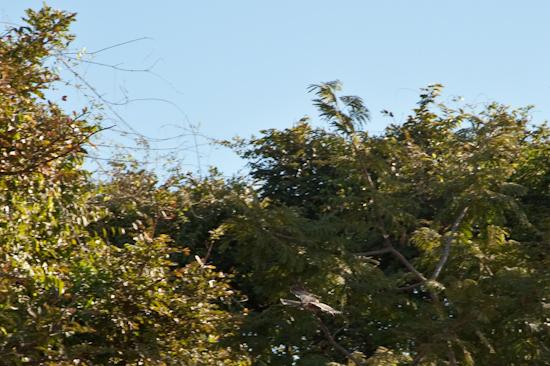 |
||

|
The Violet Turaco, Musophaga violacea; with open wings the scarlet of the flight-feathers is striking. Not wholly dependent on climax forest but certainly typical of it – the reason the bird was chosen locally for the logo of Farasuto Forest Community Nature Reserve |
Kuloro village in context
Farasuto Forest lies within Kuloro village environs and to the north on the edge of mangroves and on the main ‘south of the river’ road eastwards into the interior about five miles east of Brikama. Within living memory the settlement was at Tunjina (the name survives on some maps) among a fine stand to baobabs but the population moved to their current location by the main road when constructed some time ago. The forest is about a mile and a half from the main road, through the Tunjina trees – turn north in Kuloro by the mosque and keep going north.
Bird guides
One of Kuloro’s greatest claims to fame is that a high proportion of the Gambia’s best bird guides are from the village, members of the Kuloro Bird Club – perhaps it is something in the genes. Whatever the reason this local awareness led to the ‘discovery’ of Farasuto Forest a few years ago – or rather the realisation of its significance. Local bird guides in the habit of taking visiting birders to forests, the famous Abuko (45ha) amongst the few others, realised that they had a small but perfectly-formed forest (4.5ha) in their own village – Farasuto – another claim to fame. This local recognition culminated last year with the first Open Day for locals and visitors alike on 25 October 2008, organised by the Kuloro Bird Club, which can be regarded as the starting date for activities to conserve the forest.
While I was in the country and with a day that I could to give to their project a few of the locals organised a village meeting on 20 January 2009. While there was a realisation of the need for a plan there was no local expertise on to how to go about it.
|
Looking up at the forest canopy, with a raptor in the foreground |
Village meeting
Thus on 20 January 2009 we went to the edge of the site and there, seated under trees off the corner of the forest, the meeting went ahead with cold drinks at half-time and a fine lunch prepared by Jariatou. Present were the two Alcalos (village headmen), the Village Development Committee, members of the bird club and some others notably a dozen or more women taking time from their work in the fields – about 40 souls in all. Through an interpreter, I went through a prepared text explaining my past experience of nature reserve management and my offer to help the forest by facilitating a Management Plan for the place.
I have chaired numerous community meetings in my time but never before had I needed an interpreter – a fascinating and unforgettable experience. Unable to understand the language I (and they) relied largely on body language and facial expressions – I couldn’t take my eyes off them, scanning for responses as my words were translated.
The task ahead
The notion of ‘Think Global, Act Local’ was clearly not new and the idea that India will have to look after its tigers and China its pandas but they had their forest to look after was familiar, understood and wholly accepted. And while there may be some income to be derived I did not allude to the fact and nor did anyone else; the objective was accepted to ensure that the forest was still standing in the time of all our great-grandchildren and beyond. The entire village believes in the project.
With others from the village I visited some key people able to help. We met Mr Sanneh, manager for the Western Region Forest Department who offered his unit’s help with the plant species list and Saihou Colley of the Central Forecast Office at Banjul International Airport who kindly offered help in several aspects with respect to rainfall and temperature data over the last half-century and more, valuable information which he sent very promptly.



